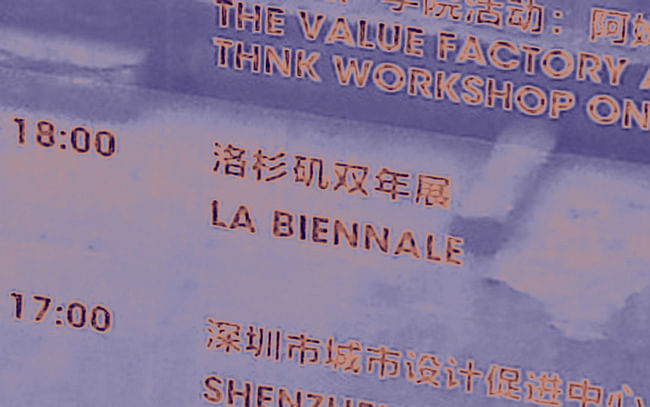

For three days this past February, eight loosely-affiliated individuals sat around a makeshift table in Shenzhen and talked about Los Angeles. This is the purely pragmatic explanation of what the Los Angeles Biennale was, in its inaugural form at 2013’s Bi-City Biennale of Architecture / Urbanism, taking place in Hong Kong and Shenzhen.
But what it is and will continue to be, is a roving experiment on discussing place. It is a discursive project, aimed at physical and conceptual digression, roving around the world to contort Los Angeles in the atmospheric lens of another city and time.

This perpetual motion machine of the LA Biennale began in Shenzhen thanks to the creative camaraderie and experimental encouragements of the Bi-City Biennale, and particularly the generosity of its Creative Director, Ole Bouman, who invited us to take part. Under the Bi-City Biennale’s “Urban Border” theme, Los Angeles and Shenzhen are sister cities -- as one of the world’s busiest container ports, Shenzhen is directly linked to Los Angeles by trans-Pacific shipping. Both cities have strong industrial heritages with designs on cultural futures. “Los Angeles”, as a heavily encoded and problematic sign in the urbanist’s landscape, readily inspires argument, idealism, passion, apathy, offense and defense -- perfect kindling for the biennale’s exploratory platform. Our role then, in Shenzhen, wasn’t to play cultural ambassador or artistic exposition-ers, but to effectively perform the moods of Los Angeles from a distance, through whatever interpretative media each individual deemed to be most fit. There was no explicit end goal, only to start something. After a couple of introductory meetings, the group of artists, architects, writers and educators settled on the following statement (which I authored as a description before the actual event):

The Los Angeles Biennale in Shenzhen is an experimentation in creating a nomadic biennale on urbanism, hosted by the Bi-City Biennale of Urbanism/Architecture. It is not possible to holistically represent Los Angeles in Shenzhen, but as a frontier-city, L.A. is constantly growing, seeking and evolving, manufacturing its progressive self. Why curb our physical boundaries, when Shenzhen and Los Angeles are partners in the traffic of a global economic network, and images of Los Angeles populate the world under all types of alternative names? Fiction is everything when every snapshot is fleeting, and we do not presume L.A. to have a sole reality. Through a hodgepodge of presentations, discussions, art pieces and interactive opportunities, the Biennale will perpetuate a generative study and performance of Los Angeles.
While contributors to the Los Angeles Biennale might not echo the familiar authorities of Los Angeles philosophizing, this was to be a smash-and-grab kind of job -- the point is to stir things up, not set them down. As contributor Andrew Wilcox put it, in Jack Kerouac’s vocabulary, this was to be “one quick move and I’m gone”. Motion is the operative function here -- never let the discussion stagnate, its participants languish. The extreme distance of Shenzhen from Los Angeles puts that principle into a definitive motion, both physical and logistical.
We arrived on a hazy Friday morning, and set up makeshift table in the aptly named Value Factory, one of the biennale’s venues repurposed from an old float-glass factory. We hoped to create something of value (natch) but temporary, nodding to the rapidly outdated function of our redressed surroundings. Whatever this experience culminated in would be an iteration that inevitably would be left behind in anticipation of the next Los Angeles Biennale -- like so many paperback novels’ delectable but disposable female cover-models.
Adjacent to a blustery entrance and the coffee bar, we occupied an inadvertently strategic position for passerbys, mostly Chinese and Dutch students or young professionals, to pause for a moment and furrow their brows at our presence. Broken in by laptops, coffee cups and Brian Mann’s spontaneous poster designs, the table was our home base for three days of presentations and discussion. We set up a projector on a nearby wall, and propped a monitor on the table to display real-time dictations of each presentation. Each contributor would have the floor to present whatever they had compiled for the biennale, followed by freewheeling discussion and questions from the rest of the group, or whoever else was passing by. After an introduction by Ole Bouman, we began.
The following is a brief description of each presentation, accompanied by recorded conversations with each contributor:
Documenting the presentations through real-time dictation wasn’t only a performance, in equal parts education and advertisement -- it was also a fabrication, on the Value Factory’s floor, of materials for the first physical iteration of this Los Angeles Biennale. We’d leave after three days with enough fodder for a simple publication, to be that “one quick move” iteration that may proliferate indiscriminately through future discussions and biennales. If this nomadism is to continue, it needs to leave a few cairns along its path.
A few weeks after we all returned home, we produced a catalog -- a collection of the text and images transcribed from our conversations in the Value Factory, designed by Brian Mann and Karen Lohrmann. You can read the entire publication here, and expect following issues for each successive Los Angeles Biennale, wherever they may fall.
Former Managing Editor and Podcast Co-Producer for Archinect. I write, go to the movies, walk around and listen to the radio. My interests revolve around cognitive urban theory, psycholinguistics and food.Currently freelancing. Be in touch through longhyphen@gmail.com
No Comments
Block this user
Are you sure you want to block this user and hide all related comments throughout the site?
Archinect
This is your first comment on Archinect. Your comment will be visible once approved.